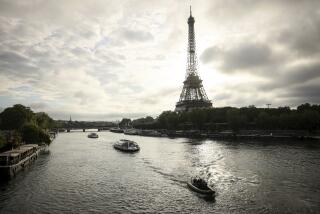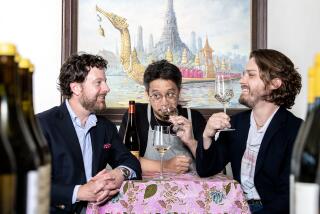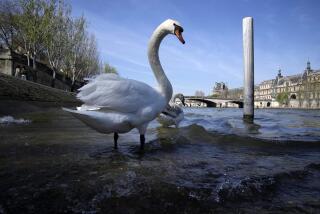Rhine River: A Waterway of History and Mystery
- Share via
KONIGSWINTER, West Germany — Julius Caesar wouldn’t be surprised by all that’s happening along the Rhine this year. Neither would Mark Twain, Victor Hugo, Goethe, Lord Byron and many others who have written about the river that flows through the heart of Europe from the Alps to the North Sea.
Expressing feelings shared by generations of travelers, Victor Hugo wrote in 1838:
“The Rhine combines everything . . . winding as the Seine . . . historic as the Tiber . . . royal as the Danube . . . mysterious as the Nile . . . sparkled with gold like a river of America . . . covered with phantoms and fables like a river of Asia. . . .”
The payoff of special promotional efforts is the likelihood that a growing percentage of U.S. visitors who come to Europe will be attracted by the sense of serenity associated with cruising by the Rhine castles and vineyards, and with driving, walking or bicycling the river roads and pathways.
Before my wife and I left Los Angeles to see what was happening along the Rhine, we received three phone calls from readers asking about this waterway of history and legend.
Fortunate Coincidence
Rhine tourism interests have also intensified promotional campaigns throughout Europe, and from Japan to South America and Africa.
By a fortunate coincidence of history, 1986 is the 160th anniversary year of KD German Rhine Line cruises. Promotions for it were under way in the United States and around the world before the gathering impact of events began to reduce the number of travelers planning to visit Europe this summer.
Historical photos and drawings were assembled to re-create earliest eras of Rhine travel, long before steamers began regular passenger service on the river between Cologne and Mainz. During the past year the KD white fleet of 22 ships carried about 1.5 million passengers.
For this anniversary year with its lower fuel prices, fares below those of 1981 are being offered by KD Rhine Line cruises. The first-class fare for a four-day, 600-mile cruise from Basle and the Swiss Alps through ever-changing scenery into France, Germany and Holland, to Rotterdam on the North Sea, starts at $609 per person, two to a cabin.
Cruise Season Extended
The cruise season has been extended this year through October, with a schedule of more than 400 sailings that include the old Roman wine country along the Moselle River.
Three new cruises will visit five countries in six days, putting out into the North Sea to reach Antwerp, Belgium, diamond-cutting capital of the world, a city rich in Flemish heritage and medieval guild houses, where Rubens painted for the last 25 years of his life.
As another special for 1986, KD Rhine Line passengers will be able to get a four-day GermanRail pass for $100, allowing two days of first-class rail travel before and after a cruise. A similar pass for second-class rail travel is $70.
Incentive for Travel
The airlines are joining in the Rhine cruise promotional efforts. Since closing the sale of its Pacific division to United Airlines in February, Pan Am has expanded its transatlantic services and has joined with the KD Line to feature the cruises as an incentive for travel to Europe this summer.
Lufthansa, Swissair and KLM airlines are highlighting Rhine cruise departure ports in Germany, Switzerland and the Netherlands.
Communities and castles along the Rhine will be having special events. For the first summer in years there will be a “Rhine in Flames” celebration starting Saturday beneath the forested crests and vineyards of the Seven Mountains between Linz and Bonn, one of the most scenic and historic stretches of the river.
The flames will be a cause for celebration. More than 2,000 small bonfires will light river-front promenades in salute to the wines and ships that helped set the course of European history. Each town will be a merriment of music, dancing and sipping. This will create a mood for the Oberdollendorf Wine Blossom Festival during June.
Werner Schaefke, director of the Cologne Municipal Museum, a scholar and author whose books include the best-selling German language guide to the Rhine, puts 1986 into perspective with presentations spanning “2,000 years of wine, art and tourism along the Rhine.”
His tourism perspective begins 200,000 years before Christ, when hunters visited the Rhineland and decided to stay. The wild grape probably grew here in prehistoric times.
The Greeks took wine drinking to southern France and the Romans advanced it to the Rhine and the Moselle. When Caesar ordered a bridge built across the Rhine in 53 BC, he was building what became a wine road more important than a military highway. The Romans stayed 400 years and brought Christianity as well as wine to the Rhine.
“Wine made this valley rich,” Schaefke told us. “Traders carried and sold our wines as far away as England and Scandinavia. With prosperity, the patrician families, the religious and temporal rulers of the Rhineland, could build the homes, castles and cathedrals, and fund the arts that will attract many visitors again this summer.”
The Rhine on Foot
We’ve just cruised the Rhine, from Duesseldorf in northern Germany to Basle in Switzerland, aboard the Italia of the KD German Rhine Line, relaxing between ports and watching the Rhineland flow by while we dined graciously, talked with new friends in the lounge or sat quietly together by the picture window in our cozy cabin.
We’ve enhanced the cruise by following the advice offered by a Baedeker guide journal in 1839: “The most pleasurable way of seeing the Rhine is undoubtedly on foot.”
Here in the medieval town of Konigswinter we are directly across the river from Bonn, capital of West Germany.
Konigswinter encapsules the experiences to be found all along the Rhine. Vineyards rise up the slopes of the Seven Mountains, where Cistercian monks began the wine growing tradition in the Middle Ages. Drachenfels (the dragon’s crag) is the nearest of the Seven Mountains.
It is where the legendary dragon was killed by Siegfried, hero of the Nibelungenleid poem composed around AD 1200. The poem became a Wagnerian opera. Lord Byron was here, too, and looked down upon the Rhine from “the castled crag of Drachenfels.”
The walk up the steep road to the castled crag takes less than half an hour, even with all the photo stops. These include the magnificent 19th-Century castle, Schloss Drachenburg, and the discovery of the mountainside Burghof Hotel.
At the summit are the ruins of the original castle built in AD 1147, with a view all the way to Cologne. If you don’t want to walk to the summit this summer, you’ll have the options of a donkey ride or the comfort of the oldest mountain railway in Germany, operating since 1883.
Within 3 1/2 hours after we sailed from Duesseldorf, the lacy spires of Cologne Cathedral came into view, rising 515 feet above the river. A walking tour of the city guided by Schaefke took us into the heart of Rhineland art and architecture, bringing it into clearer focus than ever as another high-water mark for this anniversary year.
Much of Cologne had to be restored after the World War II bombing raids, but Allied pilots were under orders to try to spare the cathedral and it survived virtually intact, including the treasured 10th-Century woodcarving of Christ on the cross. Photos show cathedral spires rising above the rubble.
Schaefke also gives an insight into the humor of medieval times. He showed us that the face on the Town Hall Tower sticks out its red tongue every hour on the hour toward what was once the rival St. Martin’s power structure.
Largest Art Gallery
Continuing on our own, we went from the treasures of the 12th-Century Gothic cathedral to the million stones of the Roman Dionysos mosaic and the Classic, Impressionist, Expressionist, Op and Pop collections in the Rhine’s largest art gallery.
During previous wanderings along the Rhine we had missed the town of Linz, which called itself “The Colorful Town” in medieval times. Now we docked near it and walked a street of half-timbered buildings to discover something new in the castle built in 1365.
It’s a museum collection of automatic musical instruments going back to times long before Thomas Edison’s talking machine. The collection represents a labor of love by food broker Klaus Fischer.
On the front of one of the half-timbered houses of Linz is the admonition that anyone who does not appreciate good wine will never be able to realize that there is more to life than the problems of the world.
Massive Fortress
Braubach was another first-time Rhine port for us, and has added the Monday Singers to the experience of Marksburg Castle, a fortress so massive and high on its hilltop that it is the only one on the Rhine unmarked by enemy attacks. As we sipped and dined within its walls, the choir of Monday Singers sang songs that my wife, Elfriede, heard as a child before emigrating with her parents to America.
Beneath the towering cliffs of the Lorelei we heard the song of the maiden who lured sailors to destruction, and then we read the words of Heinrich Heine’s verse as translated by Mark Twain, who wondered how even a legend like this could have happened where “peaceful flows the Rhine.”
More to Read
Sign up for The Wild
We’ll help you find the best places to hike, bike and run, as well as the perfect silent spots for meditation and yoga.
You may occasionally receive promotional content from the Los Angeles Times.






